[Dodge Viper RT/10]
More than three decades after the venomous Dodge Viper RT/10 slithered into view, does this brawny brute measure up to its design brief?
Words TRINITY FRANCIS Photography IAN SKELTON

Usually, I ignore comments that hint at warning sentiments, but as the metal-on-metal sound of the seat reaching the end of its rail travel rings out, I’m finding it difficult to quash those wishes of luck and courage. It turns out I’m a touch too short to fully depress the clutch of this 1994 Dodge Viper with the seat pulled all the way forward. Slouched down to reach the clutch while also being upright enough to see over the steering wheel, I tentatively pick my way through the industrial estate where the car is stored. In the wilds of Hayes, the 8.0-litre V10 of thisSRI model – facelifted SRIIs arrived in 1996 – calls out above the hum of trucks, vans and machinery. Two large potholes block my exit to the free world, and given my vertical challenges, the car’s negligible ground clearance, comically long bonnet, and left-hand-drive layout – no rhd Vipers were built – instinct and intuition are the only senses I can rely on.
On paper, there’s nothing to say that the Viper should be dangerous. Its 400bhp wanes in comparison to modern supercars and even some contemporary super sports cars. Lined up at a set of traffic lights before joining the M25, my left calf is starting to burn from the strain of pushing the clutch down with just my toes before the lights will change… I feel like I’m at the Christmas Tree light signal on a drag strip starting line. As the amber light appears, the Viper shoots off like a rocket. From this point forward, I’d like to relinquish personal responsibility for the piloting of this vehicle. I’m no longer the master of my own destiny; I’m at the mercy of the machine.
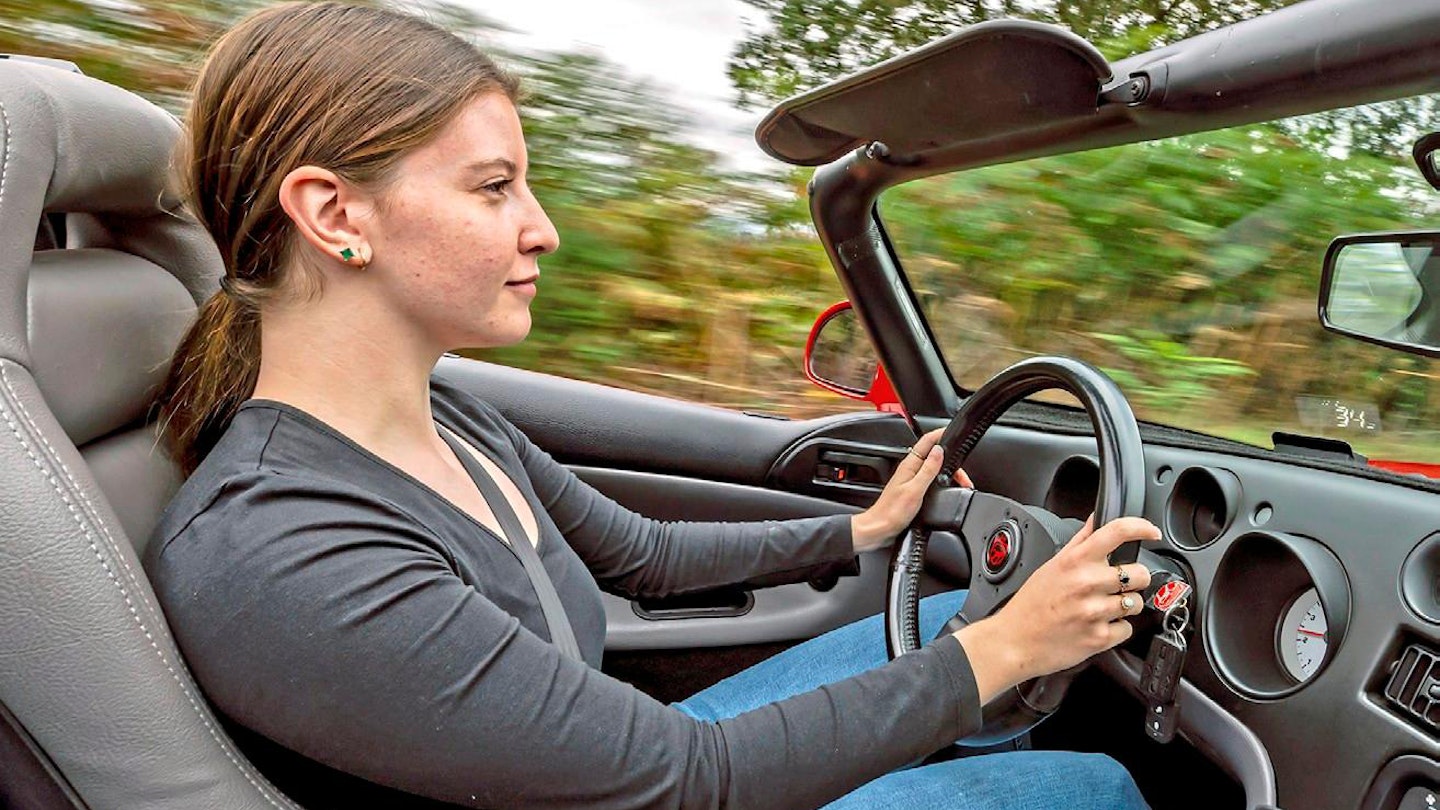
Sit down, strap in, and hold on tight…
It often takes a Hail Mary to shake up a company enough to place it back on the map, so in 1988, Bob Lutz, executive vice president of Chrysler – the owner of Dodge – set out his vision for a new two-seat sports car that would aim to embody the spirit of the Shelby Cobra. Chrysler vice president for vehicle engineering Francois Castaing and head of design Tom Gale were given the autonomy to do whatever they needed to create a modern take on the Sixties roadster, with simple engineering and styling, a huge engine and a manual transmission. President and CEO Lee Iacocca – who helped save Chrysler in the late Seventies – was another key player of ‘Team Viper’ development group. In 1989, the first Viper concept was unveiled at the North American International Auto Show, sign-off was given in 1990, and production began in 1992. Because Chrysler was focused on delivering value, and producing cars as cheaply as possible to turn around further financial woes following a hard recession, its new halo sports car needed to be thrilling, but basic.
Gale had previously worked on the Plymouth Barracuda and Dodge Challenger, so this wasn’t his first muscle car rodeo. The Cobra was undoubtedly a big influence but so were similar long-bonnet icons from the Sixties such as the Jaguar E-type, Ferrari 250GTO and Toyota 2000GT. During the Viper’s development, Chrysler still owned Lamborghini, and the Italian engineering team examined a prototype engine derived from Dodge’s iron-block ‘LA’-series unit, suggesting a conversion to aluminium to save weight, with modified castings and machined parts. Final development of the 8.0-litre V10 was developed on computer in-house at Chrysler, and with pushrod valve actuation and only two valves per cylinder – and a 50bhp per litre output – it may have not seemed the most high-tech solution for a powerful sports car. But a 488ci displacement and massive 450lb ft of torque made it quite the formidable powertrain.

No snake in the grass but serpentine references everywhere
Stopped at a junction, and with my left hand clasped around the steering wheel, right foot poised and eyes intent on the road ahead, I’m ready to fly once more. As I’m about to lift the clutch and dramatically stamp on the accelerator pedal, my focus is broken. A flash of red hair streaks across the field next to me. There’s a woman galloping across the landscape to get a closer view of the Viper. With her arms waving wildly in the air she slows to a gentle jog, forming a heart shape with her hands.
This is all the encouragement I need to give my audience-of-one a show. More an audible spectacle than a visual display of force, I disappear over the hill in a split second.

First production US ten-cylinder has 400bhp, 450lb ft
‘With a flinch of my foot, the exhaust is roaring, and the car is eating up the road’
The Viper’s brutal level of torque is on full display from a standing start. It feels like it’s just on the border of spinning the rear wheels – and if it weren’t for its massive tyres and my restraint, it would be running away before it’s caught any traction. Keeping it on the road is a full body exercise. While you power up through the shifts, the Viper demands two hands on the wheel. It’s not that it needs constant correction, rather that it wants to be firmly held on the straight so you can catch the impact of any road bumps or blemishes. Even with its targa top removed, the structure is incredibly rigid. For smooth roads and tight corners, it’s ideal, but narrow British B-roads add another layer of complexity to an already challenging situation.
Second gear knocks me back in the seat and it’s not until the car hits 60mph that I consider changing up into third, mostly to quieten the engine. The side exhausts that peep out of the door sills make it impossible to miss the sound of the V10. It’s not quite as deafening as a Cobra, but sitting at high revs for longer than is necessary will almost certainly rob you of your hearing. Despite the inherent masochism, it’s an incomparable high.
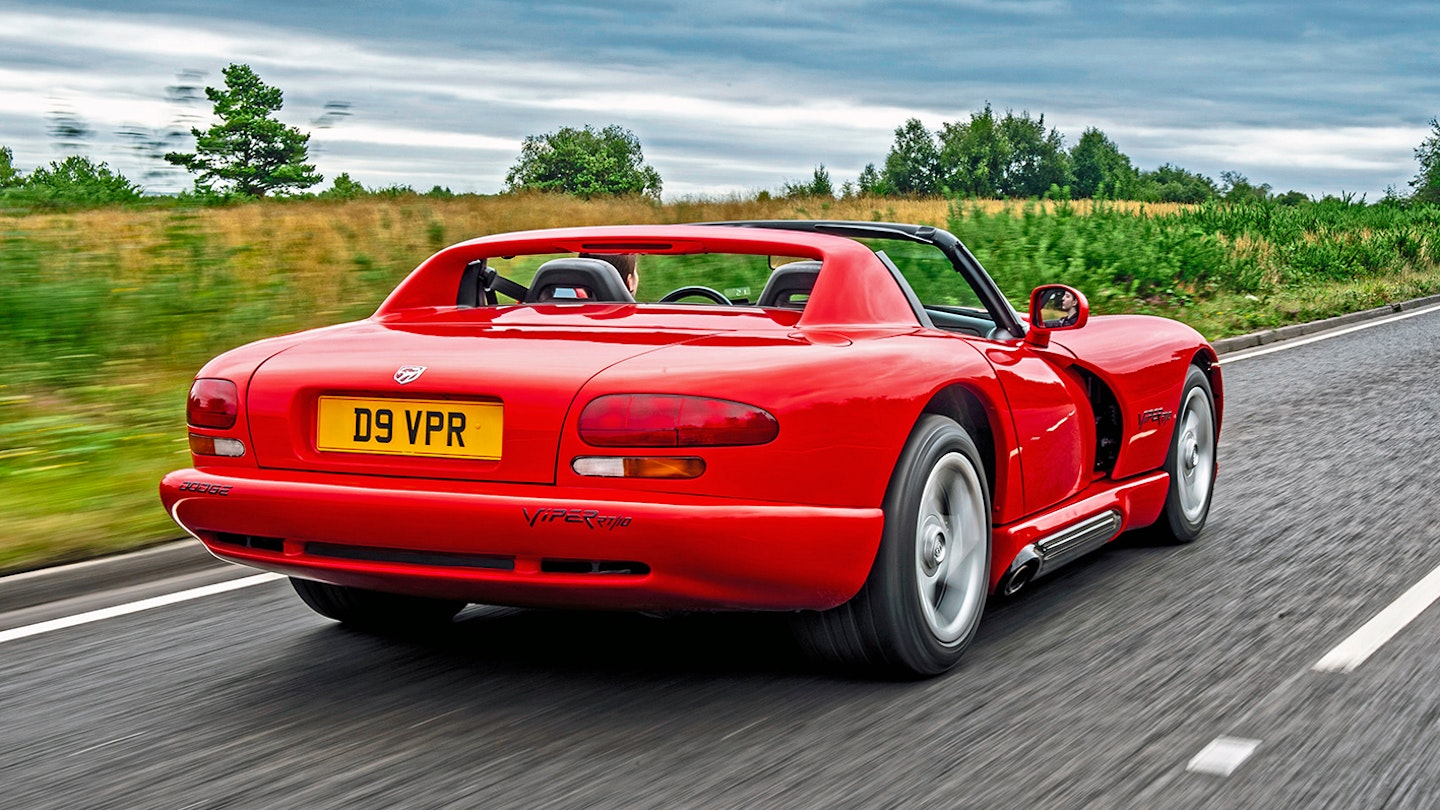
An open-top and a big engine – an enthusiast’s dream?
As the car crests the hill, I change into fourth to allow my other senses a chance to tell me what’s going on. Eyes squinted and eyelashes blowing in the wind, I realise my jaw has been wired shut the whole time. Gently prying it open, I finally get a moment to glimpse down into the cabin and chuckle at my white knuckles. This may be the definition of foolish, but it’s something I want to do again. And again. And again.
Perhaps one of its most endearing qualities is the Viper’s ability to drive like it won’t kill you. There’s an amazing duality where – if you’re gentle, it can pootle around like there’s no V10 burbling away beneath the bonnet. At speed it’s also not as manic as you might expect. This Jekyll and Hyde personality is endlessly inviting. Although the Viper can be perfectly well-behaved, it’s as if there’s a devil sitting on my shoulder.
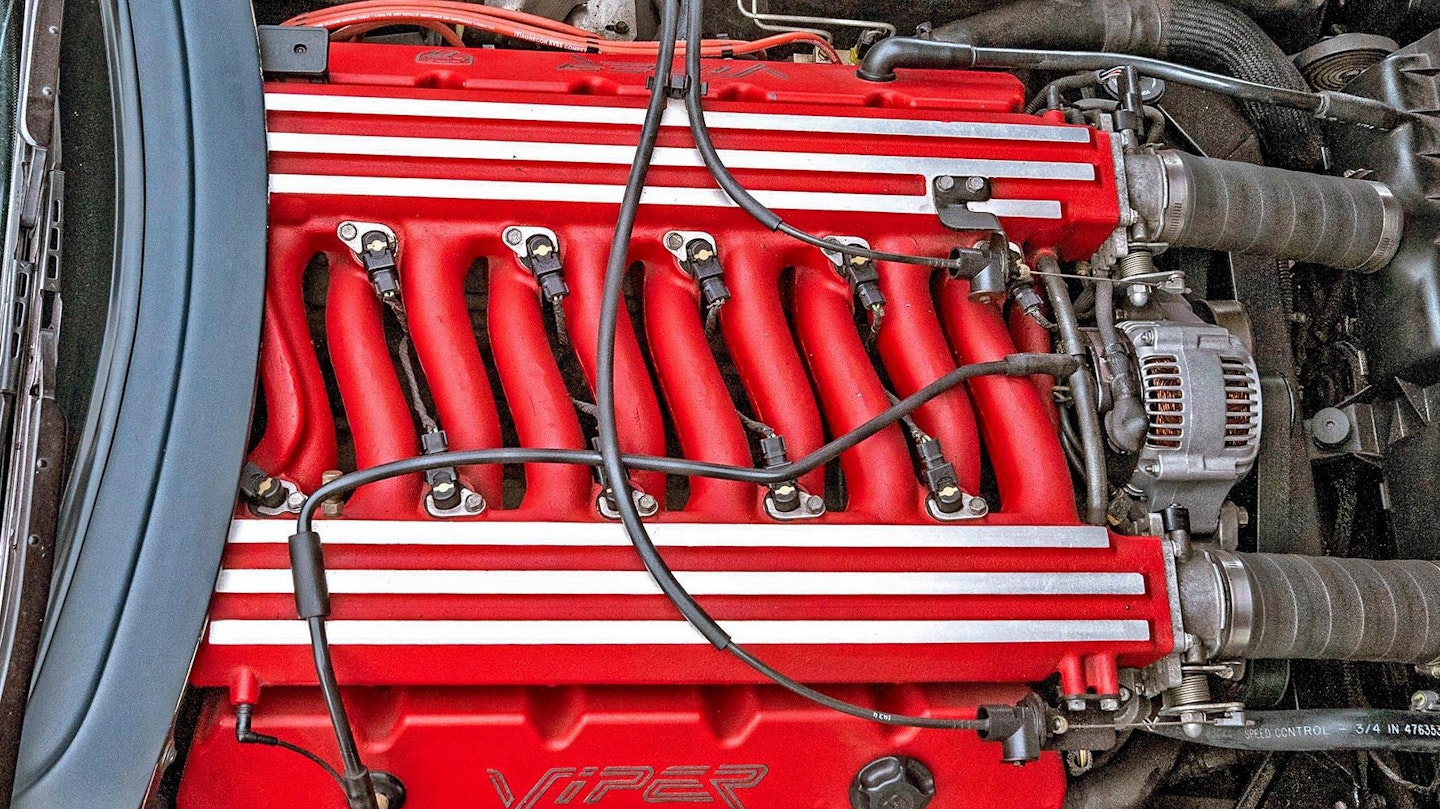
Lamborghini aided creation of aluminium V10
Suddenly, with a flinch of my foot, the exhaust is roaring, and the car is eating up the road again at an alarming rate.
There’s an almost imperceptible difference between the location of each gear across the six-speed ’box, which, at first, is a little disconcerting. It forces you to tune everything else out and focus solely on feeling the shifts. First could be third, second and fourth feel identical, and fifth is the only one that I have any confidence in. Glancing down at the gearlever reveals no shift markings to help. The accelerator is a much keener ally, and while initially, the brakes don’t feel that strong, if they were more forceful, there is a danger the car’s composure would be lost.
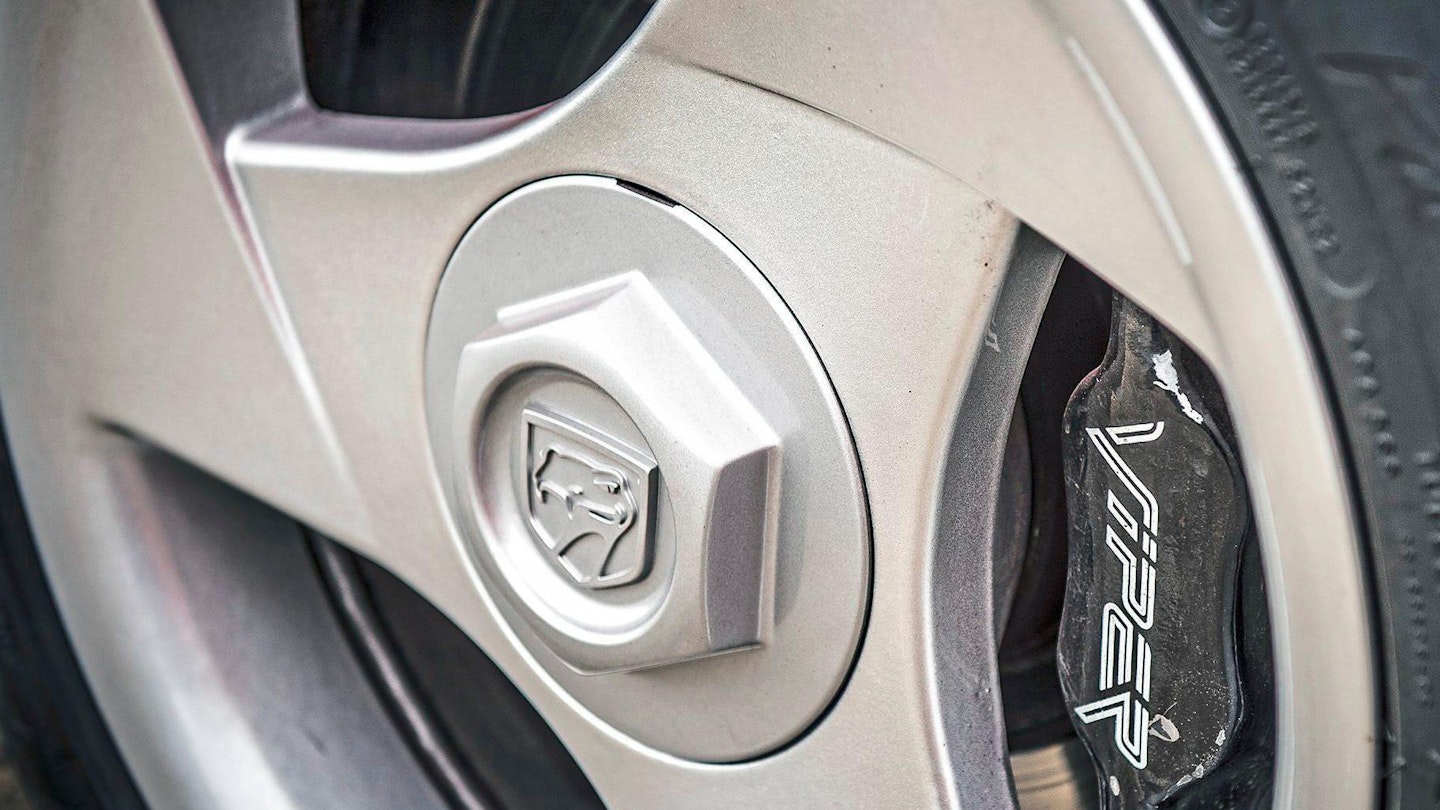
Three-spoke wheels a nod to the Nineties
With the 300kg engine nestled in front of the cabin, I was expecting Dodge’s super-roadster to feel nose heavy, but with 49/50 front-rear weight balance, the weight is almost perfectly balanced across the axles. After around half an hour, I feel that I’m at one with the car – gearchanges are mostly smooth, and any intrusive concerns have been replaced by a mischievous curiosity. Despite its hilariously long bonnet, the Viper is quite easy to place – even on narrow British B-roads – but you have to keep a firm grip on the steering wheel because it jerks about with almost too much feedback on rough-surfaced Tarmac. It's far from ideal to drive on the UK’s smaller country roads, preferring long, smooth curves instead.
Dodge almost did the car a disservice by shrouding its V10 with curvaceously smooth bodywork. It looks like the more muscular cousin of the MkII Mazda MX-5, and the almost lack of ferociously aggressive styling borders on the irresponsible. Some powerful cars make it obvious from the outset you’ll be operating a face-melting rollercoaster, but the Viper creeps up on you before you realise what’s happened.
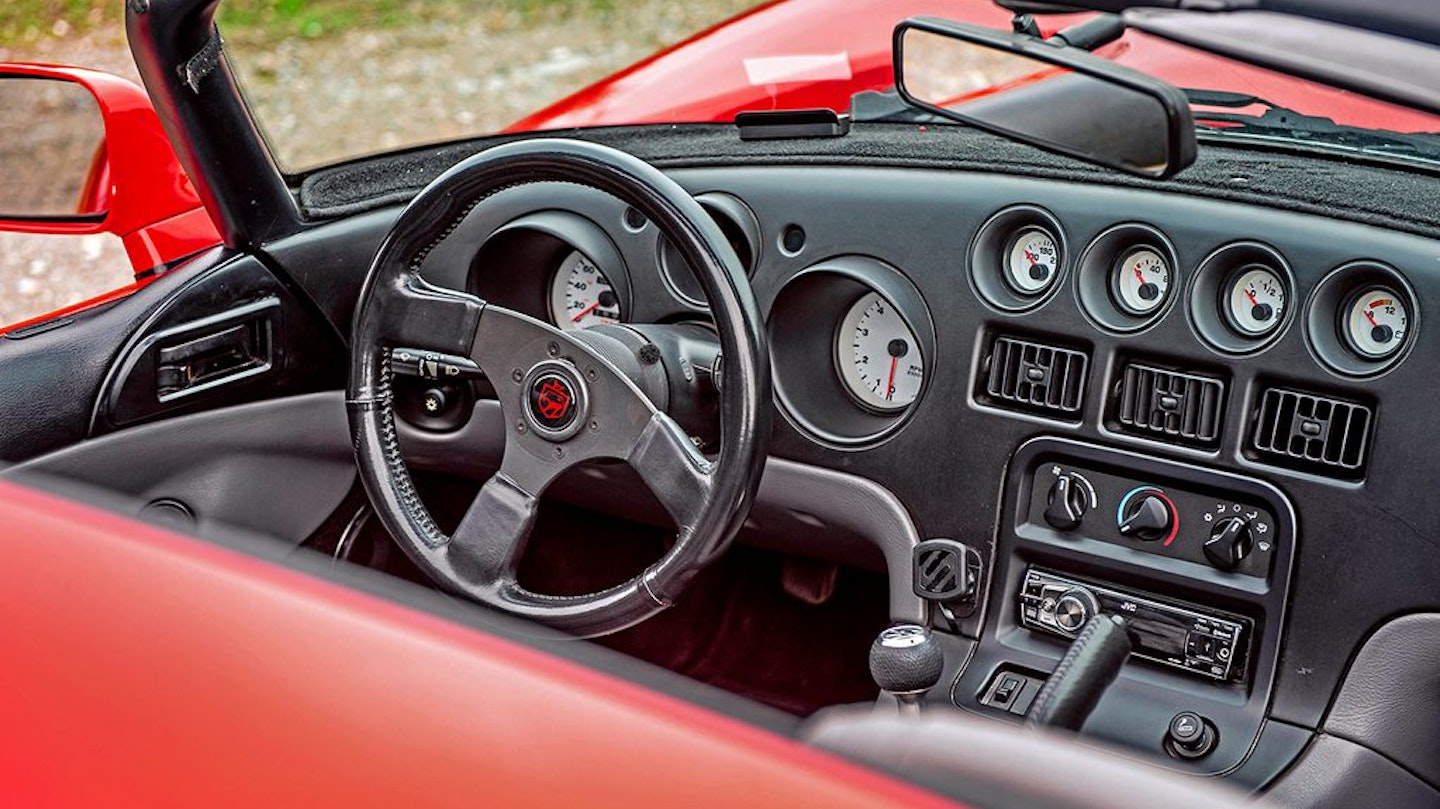
Lack of features means a lack of buttons
‘The interior is where it’s most apparent Chrysler created the Viper on a shoestring budget’
Despite creating a potentially murderous machine, in essence, what Dodge created was an enthusiasts’ dream. Open-top cruising, unthinkable force, a frill-free interior and an absolute disregard for safety. No airbags, traction control, ABS or, more basically, proper windows – SRIs had vinyl items with zips.
Vipers have always been a rare sight in the UK because even when it was new, only a double-digit number of cars was imported. Even now, exact numbers are hard to track down. I’m not sure whether it’s the machines or their owners that should be called survivors. The seatbelt mechanism is actually housed in the door, so it’s only anchored to the body of the car itself when you’re buckled in. There are no door handles on the outside of the car for helpful bystanders to open, either.
The radio is the cabin’s most high-tech feature. By modern standards, most would bemoan the interior’s scarcity of buttons but there’s a severe lack of features to control in the first place.
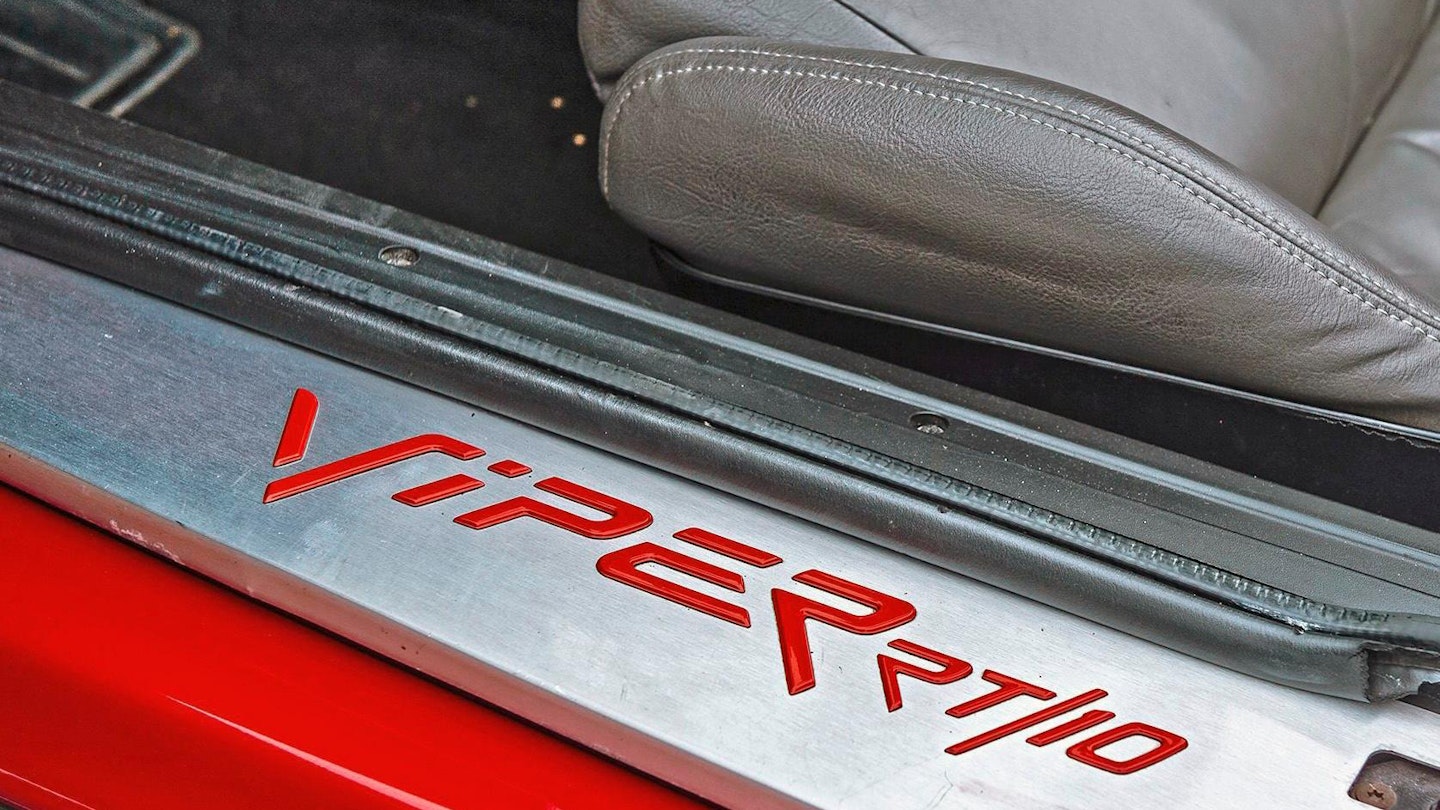
Viper designed to be a modern take on Cobra
The only movable parts are three climate dials and two fog light switches. Sadly, the snakeskin – obviously – gear lever is not a stock fitment; the Viper left the New Mack Assembly production lines in Detroit, Michigan with a very nondescript leather shifter that wouldn’t look out of place in a family minivan.
The cigarette lighter, ashtray and glovebox are the only other features in the sparse interior. This is where it’s most apparent that Chrysler created the Viper on a shoestring budget in a bid to distance the manufacturer from bankruptcy.
In addition to being a lifeline for Chrysler, the Viper ushered in several firsts. It had America's first production ten-cylinder petrol engine and signified the first time that Chrysler had cooperated with Lamborghini to create a power unit. This was also the company’s first car with a complete composite body, as well as the first volume production US model with a tubular space frame, made from steel in the Viper’s case.
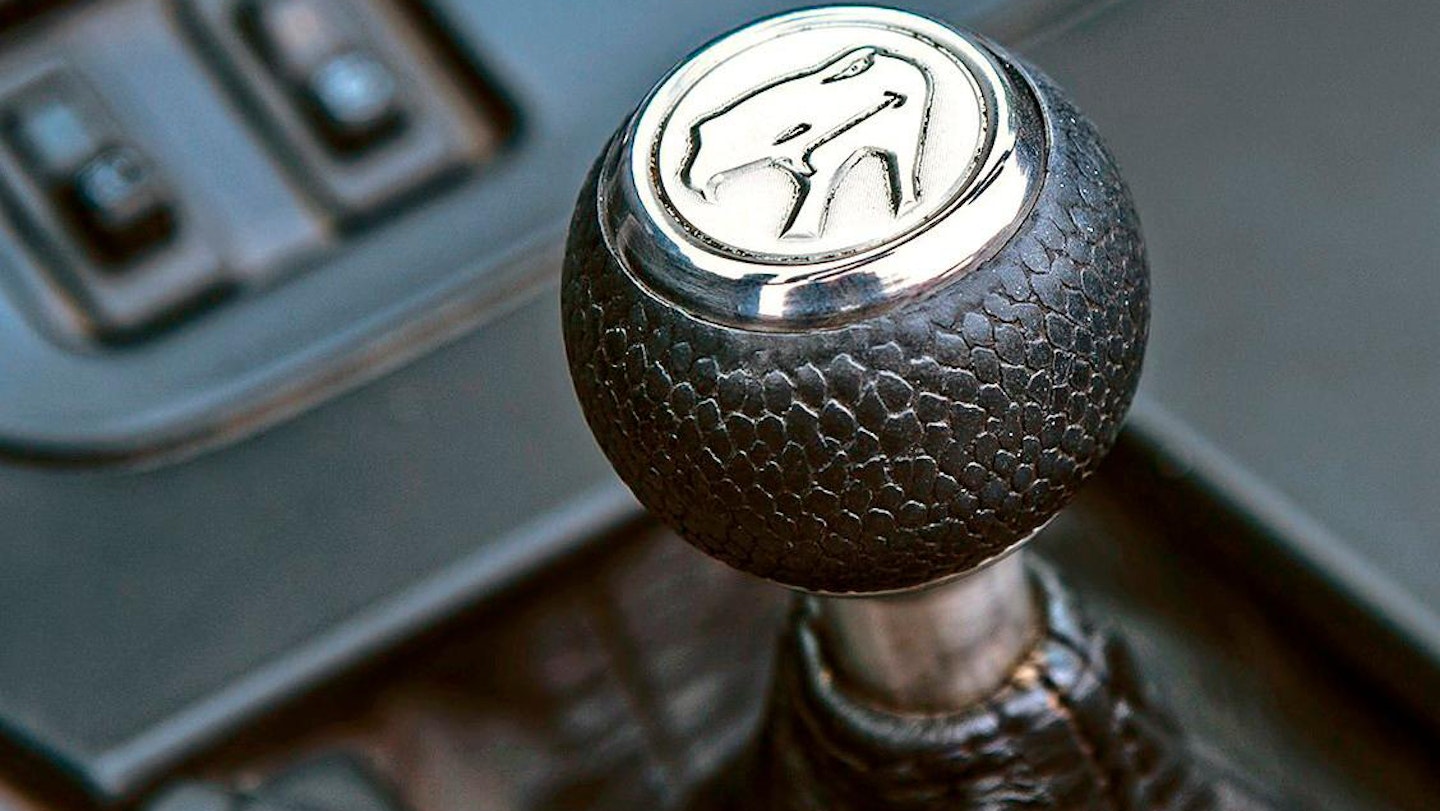
Sadly, snakeskin gearknob not standard
When the car was first revealed to the public, people went crazy for it, almost throwing money at Dodge to put deposits down. It’s even been said celebrities tried to bribe Lutz to get on the waiting list. The car did exactly what Chrysler was hoping for, creating a buzz around the brand through an outrageous model for a relative bargain £55,000 ($50,700). Back in 1990, getting anywhere near the Viper’s output would have cost you £80,499 for the 360bhp Porsche 911 Turbo 3.6 or £152,614 for the 5.7-litre, V12-powered Lamborghini Diablo with 492bhp.
Perhaps because of its low price point, the Viper wasn’t seriously pitted against supercars of the period, but it’s a hell of a lot of car for the money. You’ll stand out at every car meet and it’s likely fewer people will know what it is than you might expect. Skipping over a brief interlude from 2010-2013, the last Viper rolled off the production line in 2017. There were three defined generations in all, and small refinements kept the car evolving. Refreshed first-generation cars of 1996 are most notable by their lack of side exhausts, along with the addition of an optional removable hard-top panel and sliding glass rear windows. The GTS coupé arrived the same year, inspired by the Peter Brock-created Shelby Daytona Coupé. Lead designer Bob Hubbach counted Brock among his friends, and the 450bhp Viper GTS – which shared only 10 percent of the roadster’s parts – paid homage to the Shelby Coupé with its distinctive blue and white striped paint scheme. A ‘bubble’-roof allowed for helmeted drivers. Production of both open-top and closed-roof first-generation Vipers ended in 2002.
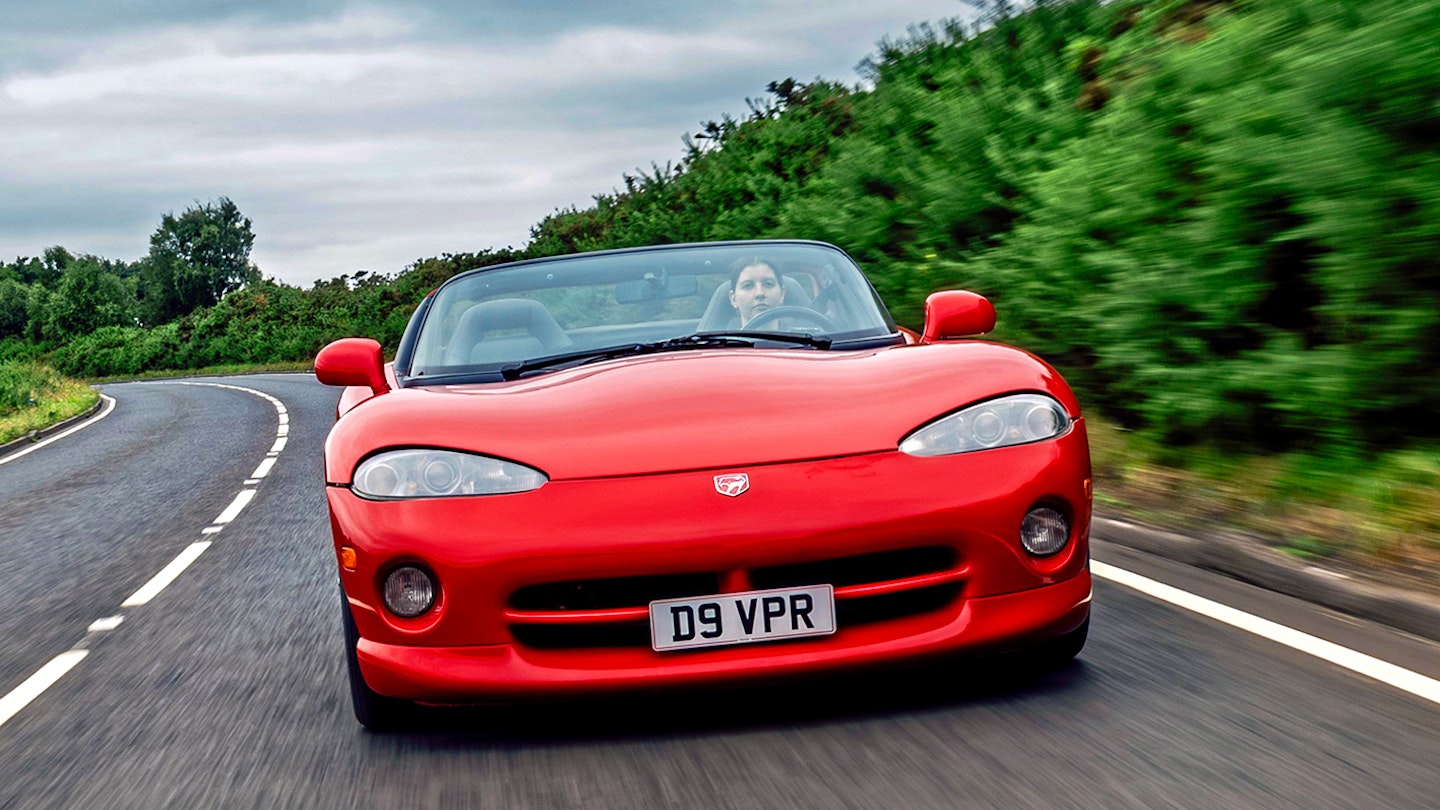
Viper’s £55k price delivered lots of bang for buck
‘The Viper has an ability to drive like it won’t kill you – there’s an amazing duality’
Second-generation ZBI Vipers were designated SRT-10 – Street and Racing Technology – denoting that the car still used a V10 engine. Now 8277cc, with 500bhp and 525lb ft of torque, a new GTS Coupé landed in 2006, both cars sharing a recognisably Viper, but sharper appearance. Revised ZBII cars of 2008 upped the anté again, with 600bhp from an 8.4-litre V10 that had seen input from Ricardo Consulting and McLaren Performance Technologies, but only enjoyed a two-year lifespan. Rumours of a third-generation car began in 2010, but it would be another three years before the VX-coded SRT Viper went on sale. More luxurious and technology-laden than previous Vipers, with 645bhp, the final cars packed the biggest road car Viper punch. Production wound up for good in the summer of 2017.
While SRI Viper roadsters had raced at Le Mans with hardtop conversions, the Viper GTS-R was a fully engineered racer, developed alongside the regular GTS Coupé. A winner from the off, the GTS-R took the 1997 FIA GT2 World Championship spoils – the first time a US maker had won the series with a production-based car – and did the same in 1998, finishing first and second in class at Le Mans.

Shrinking violet? Don’t drive a Dodge Viper…
Reclassification in 1999 failed to stop the winning streak, the GTS-R victorious in the GT class, and the SCCA GT Championship in the US.
Later Viper Competition Coupé and GT3R racers continued the success, but the original model’s run of 42 world-class competition wins from 1995-2002 – in 518, 614 and 740bhp states of tune – proved it a real rival to the best that Europe could offer.
Despite its racing wins in Europe – against the likes of Ferrari and Porsche – in the UK, a country where drag strip racing isn’t celebrated with the same cult following as America, there’s been comparatively little desire for any iteration of this US brute.

UK roads not the Viper’s ideal playground
The car was sold as the Chrysler RT/10 both here and in other selected markets, because of trademark issues surrounding the serpentine name that nods to its original Cobra inspiration, and because Dodge had little to no brand history in the UK. It’s estimated there are fewer than 40 Dodge Vipers on these shores now, just over half of which appear to wear Viper Red paintwork. You’d have to be brave, borderline unhinged to drive one every day, but you’d get unmatched pleasure and pain.
Clicking the switch down to release the key from the ignition, a sense of relief washes over me. We made it back in one piece. I’d love to say that I’d buy a Viper in a heartbeat, but it would have to really be a fair-weather track car. Yes, this monster can be driven – and enjoyed – out on the road but for the sake of longevity, it’s probably much safer on a circuit. Walking away from the quietly cooling red beast, I’m reminded of the careful warnings I received before setting off. Every one of them perfectly valid, but none serious enough to convey both the considerable danger and the incomparable joy of driving this venomous sports car.
1994 Dodge Viper RT/10
Engine 7990cc, 90° V10, ohv, sequential multipoint injection
Power and torque 400bhp @ 4600rpm; 450lb ft @ 3600rpm
Transmission Six-speed manual, rear-wheel drive
Steering Rack and pinion, power-assisted
Suspension Front and rear: independent, unequal-length upper and lower control arms, coil springs, telescopic dampers, anti-roll bar
Brakes Front and rear: vented discs, ABS
Performance Top speed: 165mph; 0-60mph: 4.5sec
Weight 1522kg (3356lb)
Fuel consumption 15mpg
Cost new £55,000 (1992, US: $50,700)
Classic Cars Price Guide £21,000-£35,000
OWNING A DODGE VIPER
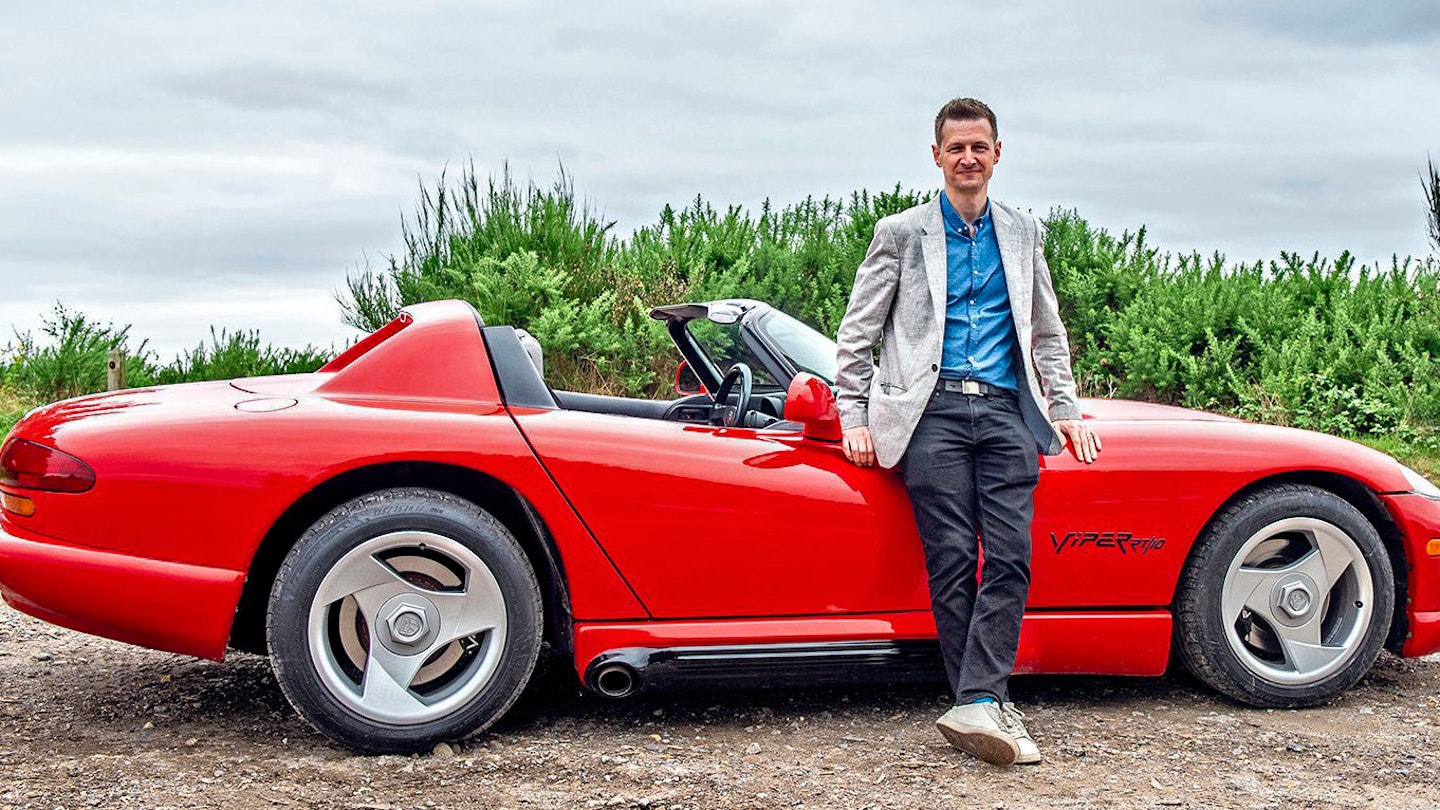
‘I was 14 when Chrysler unveiled the Viper concept. I saw this magazine spread and put it on my bedroom wall. It was the most stunning thing ever,’ says Ashley Winston. ‘I knew then that concept cars never became real cars but when it was released it looked exactly like the concept. I’ve never been actively looking for one, but I always knew I would have one. I bought this one in 2024. It came with chrome wheels, but I swapped them back to the original rims and put a new set of tyres which were as expensive as those on my Ferrari Testarossa because they’re so big – 275-section at the front, and 335 at the back. I did a tunnel run in it, and the alternator died at 2am – but apart from that, it’s been reliable, with any work needed carried out by my general mechanic. Parts are trickier, though – I tracked down some original side vents, but that wasn’t without challenge.’
Subscribe to Classic Cars today. Choose a Print+ Subscription and you'll get instant digital access and so much more. PLUS FREE UK delivery.